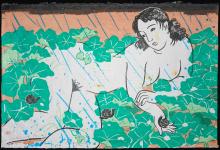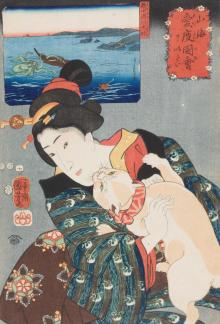Back
“Woman was the Sun” | Art of Japanese Women
ODA Mayumi 小田檀 (Japanese-born American, b. 1941). Garden in Rain, 1981. Sōsaku hanga woodblock print; ink and color on paper, edition AP, 24 x 35 5/8 inches. Gift from the Asian Art Collection of Alice and Jack Hardesty
UTAGAWA Kuniyoshi 歌川國芳 (1797-1861) and UTAGAWA Yoshitori-jo 歌川芳鳥女 (1839-circa 1870) Japanese; Edo period, 1852, Ouch! That Hurts! (Ô itai), from the series Celebrated Treasures of Mountains and Seas (Sankai medetai zue), Ukiyo-e woodblock print in vertical ôban format; ink and color on paper, H. 14 ¼ x W. 9 ¾ inches. Loan from the Lee & Mary Jean Michels Collection, LMM.0455
“Woman was the Sun” | Art of Japanese Women
November 11, 2023 to August 04, 2024
Pioneering feminist Hiratsuka Raichō (1886-1971) began the 1911 issue of Japan’s first all-women literary journal Seitō (Bluestocking) with the words “In the beginning, woman was the sun,” a reference to the legend that the Japanese imperial family descended from the Shintō Sun Goddess Amaterasu Ōmikami.* Despite these illustrious origins, the status of women declined over 2,000 years of Japanese history to the extent that by the late nineteenth century they came to be viewed primarily as subservient accessories to men – “good wives and wise mothers” (ryōsai kenbo) or political pawns – rather than for their individual merit, intelligence, or creativity.
In conjunction with the 50th anniversary of the University of Oregon’s Center for the Study of Women in Society, this installation celebrates Japanese women through paintings, calligraphy, prints, sculpture, and decorative art from the permanent collection augmented with a selection of distinguished loans. The artists represented range from nineteenth-century Buddhist poet, calligrapher, and ceramicist Otagaki Rengetsu (1791-1875) and painter Noguchi Shohin (1847-1917) through cutting-edge contemporary artists Kusama Yayoi (born 1929), Aoshima Chiho (born 1974), and Nagare Manika (born 1975), photographer Kaneko Hiroyo (born 1963), manga artist Hagio Moto (born 1949), calligraphers Jō-Amidabutsu (active circa 1228-1240), Matsubara Reiko (active circa 1923), and Shinoda Tōkō (1913-2021), printmakers Utagawa Yoshitori-jo (1839-circa 1870), Minami Keiko (1911-2004), Iwami Reika (1927-2020), Mayumi Oda (born 1941), Betty Nobue Kano (born 1944), Asahi Mio (born 1957), and Ozeki Ritsuko (born 1971), and prints by three generations of female Yoshida artists: grandmother Yoshida Fujio (1887-1987), mother Yoshida Chizuko (1924-2017), and daughter Yoshida Ayomi (born 1958). The installation also features female subjects such as religious and literary figures, warriors, heroines, villains, and demons, and a selection of tea-related objects intended for curricular use. Woman was the Sun was organized by chief curator Anne Rose Kitagawa in collaboration with art history professor Akiko Walley. A few additional works created by Japanese women will be on view in the faculty-curated exhibition Artists, Constellations and Connections: Feminist Futures in the Schnitzer Gallery during the Winter and Spring terms of 2024.
*“In the beginning, woman was the sun, an authentic person. Now she is the moon, a wan and sickly moon, dependent on another, reflecting another’s brilliance.” – Hiratsuka Raichō in Seitō (Bluestocking), 1911. Translated by Teruko Craig.








